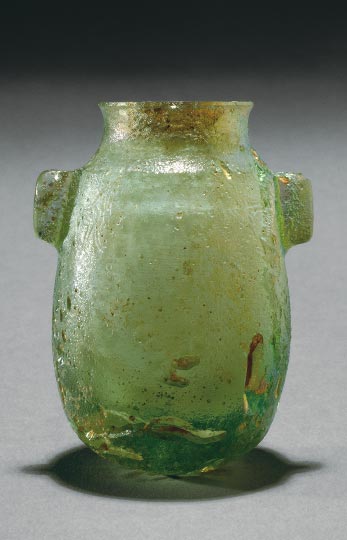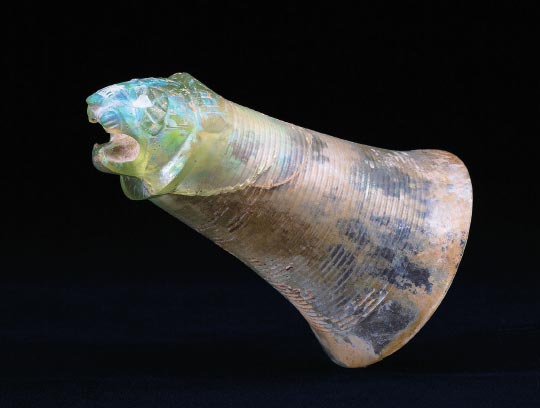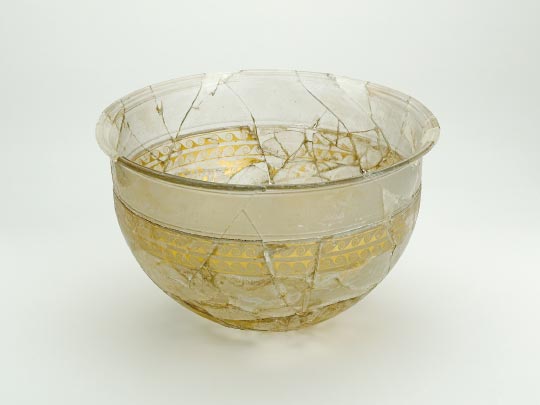
 |
The Sargon Vase
Neo Assyria (now Iraq), 721–705 B.C. The British Museum © The Trustees of the British Museum
When we think of glass, we are prone to imagine translucent
cups or clear windows, however, such nearly colorless,
transparent glass came to be made over 1500 years after
glass was first invented. This remarkable jar, known as the
earliest dated glasswork, was fused with powdered glass to
create its shape. After forming a rocklike cluster, the
inside was picked out with a tool. This piece was discovered with many small alabaster jars at the Northwest Palace in Nimrud—the once capital of the Assyrian empire, which dominated the world of the Orient, on the riverside of the Tigris. The shoulder of the jar are inscribed with cuneiform letters “Palace of Sargon, King of Assyria” and a figure of a lion, revealing that that the vessel was produced during the time of Sargon II (r. 722–705 BCE). |

Fluted Cup Terminating in a Lion’s Head
Achaemenid Persia, 5th–4th century B.C.
MIHO MUSEUM
Achaemenid Persia, 5th–4th century B.C.
MIHO MUSEUM
A play by Aristophanes (act. 427–386 BCE), a
comic playwright of ancient Greek, describes a scene in which a
Greek emissary visited the court of the powerful Persian Empire
and was received with a great banquet. There, the Persians
served sweet wine in gold and transparent glass vessels. This
cup may have been such a piece. The lion carving and the overall
horn-shape with concentric rings amply reflect the Persian-style
design of the time. The color of the natural glass was removed
by casting it and adding a material called antimony. Its
transparency and beautifully crafts cuts demonstrate the
execution of an extremely high degree of knowledge and
technique. Such a perfect glass cup stands alone as a rare gem.

Bowl with Acanthus Design
Eastern Mediterranean (excavated from Canosa Tomb di Puglia 9, Italy), circa 250 B.C.
The British Museum
© The Trustees of the British Museum
Eastern Mediterranean (excavated from Canosa Tomb di Puglia 9, Italy), circa 250 B.C.
The British Museum
© The Trustees of the British Museum
The numerous Hellenistic glass burial accessories discovered at
the Canosa tombs in Southern Italy astonished the world. This
bowl was found along side unprecedented large mosaic glass
plates and extravagant examples of cut glass.
This work was made from a technique known as gold sandwich in which gold leaf was cut to create extremely intricate acanthus and wave patterns across the entire bowl. The gold design was placed precisely between two layers of clear glass, creating a lustrous scenery in the piece. This work is among the finest examples of gold-glass bowls and represents a proud treasure of the British Museum. A reproduction using the traditional Japanese kirikane (cut gold) technique is displayed in this exhibition.
This work was made from a technique known as gold sandwich in which gold leaf was cut to create extremely intricate acanthus and wave patterns across the entire bowl. The gold design was placed precisely between two layers of clear glass, creating a lustrous scenery in the piece. This work is among the finest examples of gold-glass bowls and represents a proud treasure of the British Museum. A reproduction using the traditional Japanese kirikane (cut gold) technique is displayed in this exhibition.